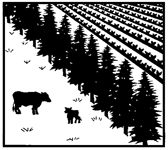United States Department of Agriculture, Forest Service, National Agroforestry Center

Agroforestry Notes (USDA-NAC)
Date of this Version
March 2002
Document Type
Newsletter Issue
Citation
National Agroforestry Center, United States Department of Agriculture, Forest Service, Rocky Mountain Station, United States Department of Agriculture, Natural Resources Conservation Service, Lincoln, Nebraska
Abstract
Biotechnical streambank protection utilizes living plant materials to reinforce soil and stabilize slopes. Plants can be used as the primary structural component or in combination with inert materials like rock, concrete, and steel to help stabilize streambanks. Many terms have been used to describe the engineering use of plant materials for slope stabilization (Figure 1). The Natural Resources Conservation Service (NRCS) uses the term Soil Bioengineering to describe the use of living plant material for soil reinforcement, hydraulic drains, barriers to earth movement, and hydraulic pumps or wicks. The underlying concept for all terms is the use of plants to reduce the erosive forces of water and increase soil's resistance to those erosive forces.
Biotechnical stabilization is not a new concept. Documented examples of its use date back to the Romans. There are numerous references from the 1930s that advocated biotechnical designs. The NRCS (previously the Soil Conservation Service) utilized extensive biotechnical techniques on the Winooski River Watershed project in Vermont that has been well documented since its installation in 1938. After World War II these techniques seemed to have lost favor to the hard engineering approaches that rely heavily on rock, concrete, and steel. However, the growing concern for more ecologically beneficial solutions has renewed interest in biotechnical approaches.


Comments
United States government work